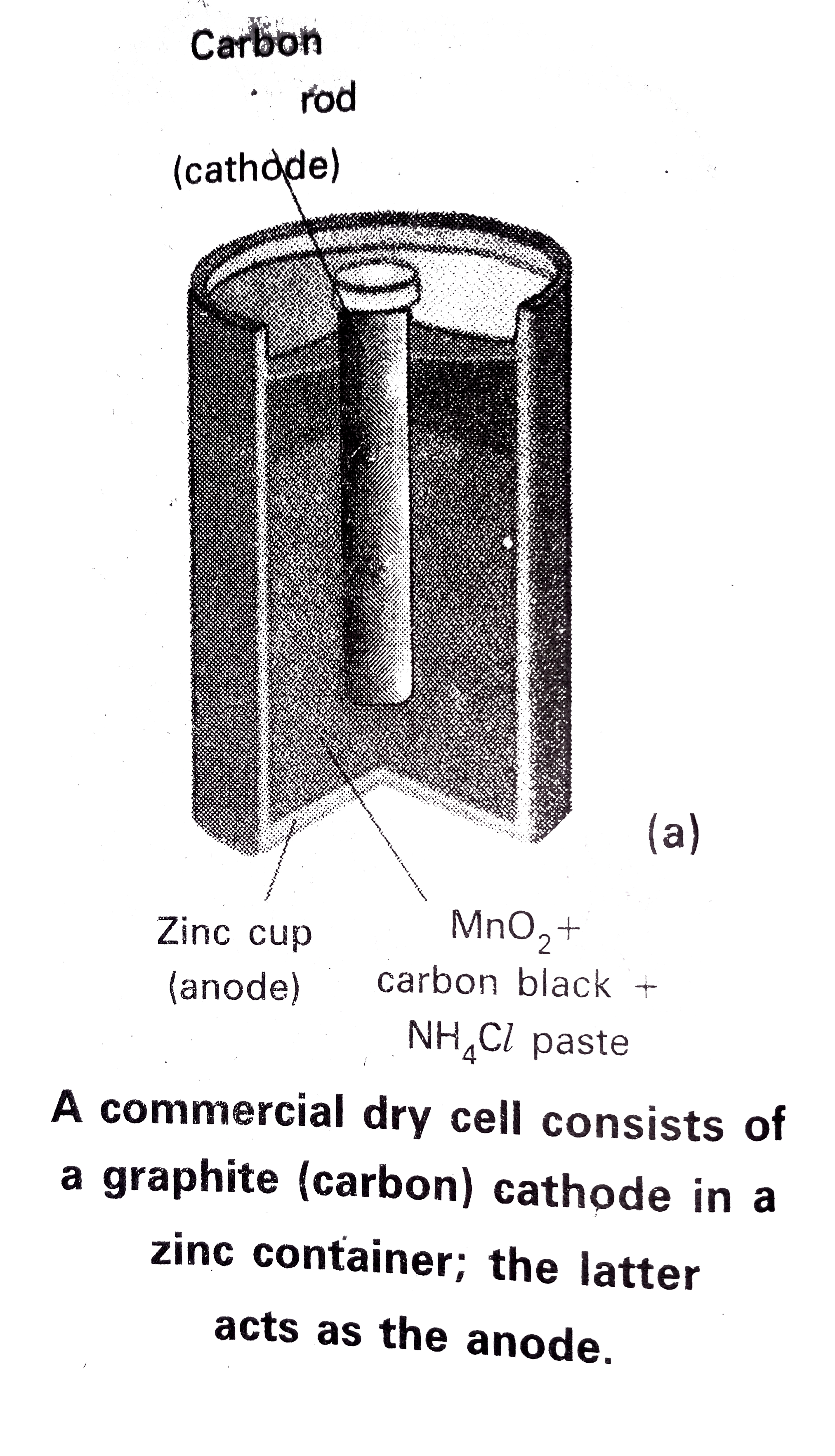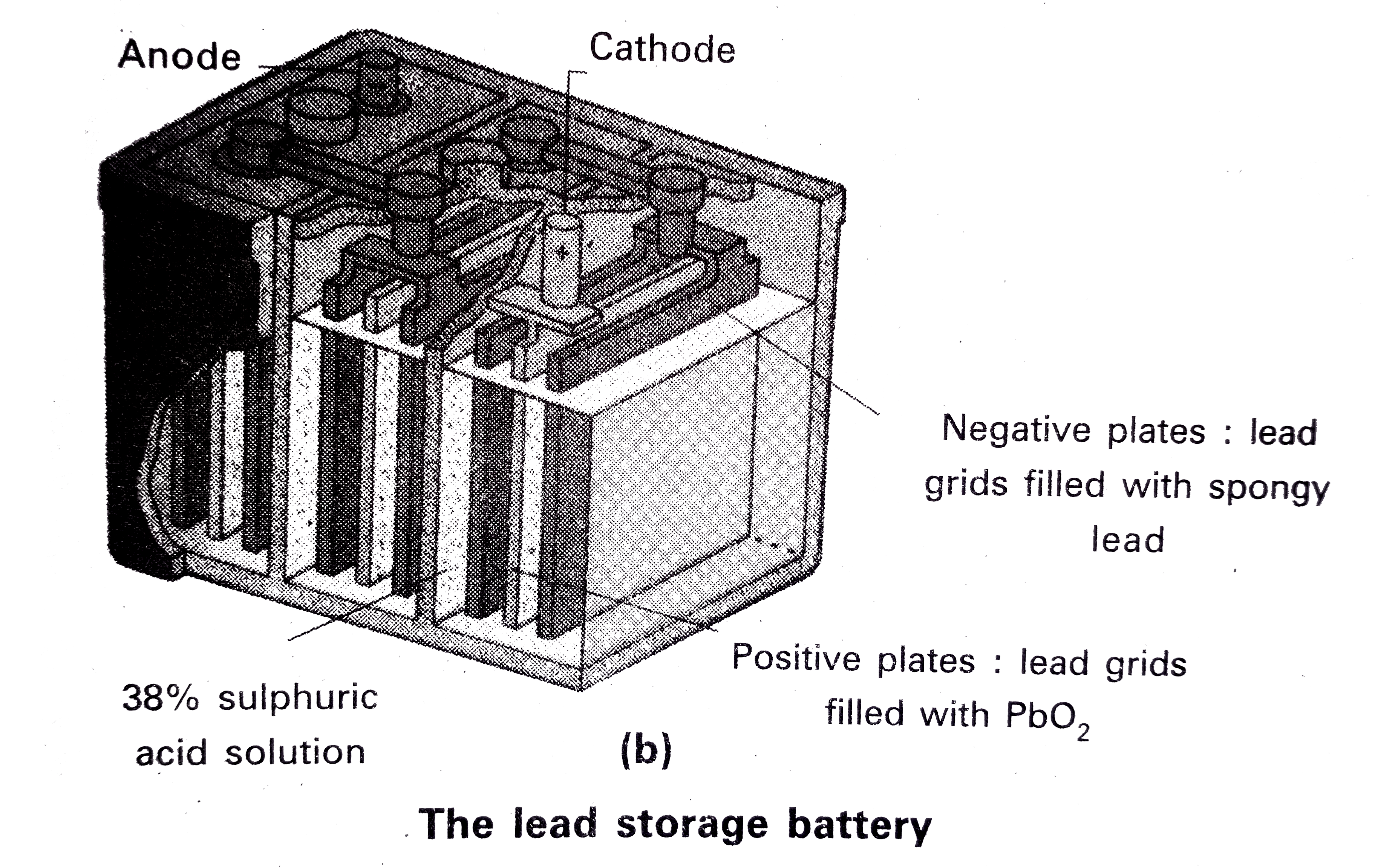Given the different types of batteries and explain the construction and working of each type of battery.
The batteries which after their use over a period of time, becomes dead and the cell reaction is completed and this connot be reused again are called primary batteries.
Eg.: Leclanche cell, dry cell.
Secondary battery :
A secodary battery is the battery in which after it's use can be reached and can be used again.
A good secondary battery undergoes large no. of discharging and charging cycles.
Lead stronge battery is an example of secondary battery.
The cell reactions when the battery is in use are
Pb(s)+SO−24(aq)→PbSO4(s)+2e− (Anode)
PbO2(s)+SO−24(aq)→4H+(aq)+2e−→PbSO4(s)+2H2O(l)(Cathode)
Overall cell reaction is
Pb(s)+PbO2(s)+2H2SO4(aq)→2PbSO4(s)+2H2O(l)
Construction and working of primary batteries :
Dry cell :
1. This is a modification of Leclanche cell. The liquid state electrolytes (in Lecanche cell) are replaced by paste electrolytes.
2. A cylindrical 'Zn' vessel is covered with a cardboard. This is selected with pitch. Zn vessel acts as negative electrode. A carbon rod is introduced at the centre of the Zn vessel. This carbon rod acts as positive electrode.
3. Carbon rod is surrounded by a paste of (C+MnO2). The remaining space is filled with (NH4Cl+ZnCl2).
The remaining space is filled with (NH4Cl+ZnCl2)
paste. The two pastes are separated by a porous sheet.
4. These cells are easy to handle and used in radios, watches, torch lights etc. The cell potential is approximately 1.5 V.
5. Electrode reactions :
Cathode :MnO2+NH+4+eΘ→MnO(OH)+NH3
Anode :Zn+2MnO2+2H2O→Zn2++2OHΘ+2MnO(OH)
Some of the secondary reactions are
2NH4Cl+2OHΘ→2NH3+2Cl−+2H2O
Zn2++2NH3+2Cl−→[Zn(NH3)2]Cl2
Secondary batteries - construction and working : A secdary cell after its use can be recharged and can be used again. A good secondary cell undergoes a large number of discharging and charging cycles. The most important secondary cell in use is the lead storage battery (gig (b)). This is commonly used in automobiles and invertors. It consists of a lead anode and a gird of lead packed with lead dioxide (PbO2) as cothode.A38% solution of sulphuric acid is used as electrolyte.
The cell reactions when the battery is in use (discharging) are :
Anode :Pb(s)+SO24(aq)→PbSO4(s)+2e−
Cathode :PBO2(s)+SO−4(aq)+4H+(aq)+2e−→PbSO4(s)+H2O(l)
i.e., overall cell reaction consisting of cathode and anode reactions is
Pb(s)+PbO2(s)+2H2SO4(aq)→2PbSO4(s)+2H2O(l)
These reactions occur during discharge i.e., during use of the bettery.
On charginig the discharged battery the above reaction is reversed and PbSO4 (s) on anode and cathode is converteed into Pb and PbO2, respectively.


Topper's Solved these Questions
- BOOK - VIKRAM PUBLICATION ( ANDHRA PUBLICATION)CHAPTER - ELECTROCHEMISTRY & CHEMICAL KINETICSEXERCISE - INTEXT QUESTIONS24videos
ELECTROCHEMISTRY & CHEMICAL KINETICS
- BOOK - VIKRAM PUBLICATION ( ANDHRA PUBLICATION)CHAPTER - ELECTROCHEMISTRY & CHEMICAL KINETICSEXERCISE - DAM SURE18videos
ELECTROCHEMISTRY & CHEMICAL KINETICS
- BOOK - VIKRAM PUBLICATION ( ANDHRA PUBLICATION)CHAPTER - ELECTROCHEMISTRY & CHEMICAL KINETICSEXERCISE - SHORT ANSWER QUESTIONS25videos
ELECTROCHEMISTRY & CHEMICAL KINETICS
- BOOK - VIKRAM PUBLICATION ( ANDHRA PUBLICATION)CHAPTER - D AND F- BLOCK ELEMENTS AND CO-ORDINATION COMPOUNDS EXERCISE - INTEXT QUESTIONS33videos
D AND F- BLOCK ELEMENTS AND CO-ORDINATION COMPOUNDS
- BOOK - VIKRAM PUBLICATION ( ANDHRA PUBLICATION)CHAPTER - GENERAL PRINCIPLES OF MMETALLURGYEXERCISE - DAM SURE SAQ1videos
GENERAL PRINCIPLES OF MMETALLURGY
Similar Questions
What does a soda-acid type of ire extinguisher contain? How does it work? Explain the working of a soda-acid fire extinguisher with the help of a labelled diagram.
View SolutionExplain different types of waves .
View SolutionExplain the different types of transpiration.
View SolutionExplain the different types of dichogamy.
View SolutionWhat are different types of interactions? Explain.
View SolutionExplain the working of lead storage battery.
View SolutionWhat is a fire extinguisher? Explain the construction and working of a soda acid type fire extinguisher.
View SolutionExplain different types of earthquakes.
View SolutionName different types of projections on the basis of method of construction.
View SolutionExplain different types of projection.
View Solution

